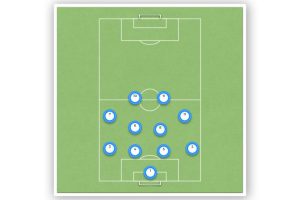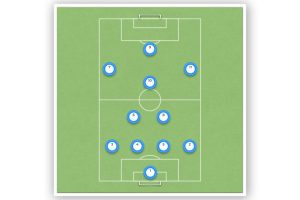Mastering Midfield Balance in 4-3-3 Formation
A well-balanced midfield is essential for any team that wants to play an attacking style of soccer. The 4-3-3 formation is a popular choice for coaches who want to create a strong midfield presence. This formation has three central midfielders who can control the game and provide support for the attack and defense.
When playing in a 4-3-3 formation, the midfielders must understand their roles and responsibilities well. The central midfielder is usually the playmaker who controls the tempo of the game and distributes the ball to the attacking players. The two wide midfielders provide width to the attack and support the fullbacks in defense.
One of the key aspects of a well-balanced midfield is the ability to rotate positions. This means that the central midfielder can move out wide to support the attack, while one of the wide midfielders drops back to cover the central midfield position. This rotation creates confusion for the opposition and makes it difficult for them to mark the midfielders effectively.
Importance of Midfield Balance in 4-3-3
The 4-3-3 formation is a popular and versatile formation in soccer. One of its key strengths is its midfield balance, which is crucial for both defensive and attacking play. In a 4-3-3 formation, the midfielders are responsible for controlling the game and providing support to both the defense and attack.
The three central midfielders in a 4-3-3 formation must work together to maintain balance and control of the midfield. The central midfielder in the defensive role is responsible for protecting the backline and breaking up opposition attacks. The two central midfielders in the attacking role are responsible for creating chances and supporting the forwards.
When the midfield is balanced, it allows the team to maintain possession and control of the game. The midfielders can quickly switch the play from one side of the field to the other, creating space and opportunities for the forwards to attack.
| Defensive Midfielder | Central Midfielders |
|---|---|
| Protects the backline | Creates chances and supports the forwards |
| Breaks up opposition attacks | Controls the midfield |
However, if the midfield is unbalanced, it can lead to gaps in the defense or a lack of creativity in attack. For example, if the central midfielders are too attack-minded, they may leave the defense exposed to counter-attacks. On the other hand, if the central midfielders are too defensive-minded, they may struggle to create chances for the forwards.
Therefore, it is important for the coach to select midfielders who can work together effectively and maintain balance in the midfield. The coach should also provide tactical instructions to the midfielders to ensure that they are fulfilling their roles effectively.
- The defensive midfielder should focus on protecting the backline and breaking up opposition attacks.
- The central midfielders should focus on controlling the midfield and creating chances for the forwards.
- The wingers should provide support to the midfielders and forwards and help to stretch the opposition defense.
In conclusion, midfield balance is crucial in a 4-3-3 formation. The midfielders must work together effectively to maintain control of the game and provide support to both the defense and attack. The coach should select midfielders who can fulfill their roles effectively and provide tactical instructions to ensure that the midfield is balanced.
Role of Central Midfielders in 4-3-3
Defensive Midfielder
The defensive midfielder in the 4-3-3 formation is responsible for providing cover to the back four and breaking up the opposition’s attacks. They are typically positioned in front of the center backs and are the first line of defense. Their main job is to win the ball back and distribute it to the more attacking players.
The defensive midfielder should have excellent defensive skills, including tackling, marking, and intercepting. They should also be comfortable with the ball at their feet and have good passing skills. They need to be able to read the game and anticipate the opposition’s movements to position themselves correctly.
Some examples of great defensive midfielders in the 4-3-3 formation include Sergio Busquets of Barcelona and Fabinho of Liverpool.
Box-to-Box Midfielder
The box-to-box midfielder in the 4-3-3 formation is responsible for covering the entire length of the pitch. They are the engine room of the team and are involved in both attacking and defending. Their main job is to link up with the attacking players and provide support to the defensive midfielders.
The box-to-box midfielder should have excellent stamina and be able to cover a lot of ground. They should also have good passing and shooting skills, as they are often involved in attacking moves. They need to be able to read the game and anticipate the opposition’s movements to position themselves correctly.
Some examples of great box-to-box midfielders in the 4-3-3 formation include Kevin De Bruyne of Manchester City and N’Golo Kante of Chelsea.
Attacking Midfielder
The attacking midfielder in the 4-3-3 formation is responsible for creating chances and scoring goals. They are typically positioned behind the striker and in front of the box-to-box midfielder. Their main job is to link up with the striker and provide support to the attacking players.
The attacking midfielder should have excellent dribbling, passing, and shooting skills. They need to be able to read the game and anticipate the opposition’s movements to position themselves correctly. They should also be able to create chances for themselves and their teammates.
Some examples of great attacking midfielders in the 4-3-3 formation include Kevin De Bruyne of Manchester City and Bruno Fernandes of Manchester United.
| Position | Defensive Skills | Passing Skills | Shooting Skills | Examples |
|---|---|---|---|---|
| Defensive Midfielder | Excellent | Good | Poor | Sergio Busquets, Fabinho |
| Box-to-Box Midfielder | Good | Good | Good | Kevin De Bruyne, N’Golo Kante |
| Attacking Midfielder | Poor | Excellent | Excellent | Kevin De Bruyne, Bruno Fernandes |
Wing Play and Midfield Balance in 4-3-3
The 4-3-3 formation is known for its attacking prowess, and one of the key elements that contributes to this is the use of wingers. The two wide players in the front three are typically tasked with providing width and stretching the opposition defense. However, their role also has a significant impact on the balance of the midfield.
When the wingers are positioned high up the pitch, it can leave the midfield exposed and create a gap between the midfield and defense. This can be especially problematic when the opposition is in possession and looking to launch counter-attacks. Therefore, it is crucial for the midfielders to adjust their positions and provide cover for the full-backs when the wingers are higher up the pitch.
On the other hand, when the wingers drop deeper to help defend, it can create a more compact and solid midfield. This can be useful when the team is trying to protect a lead or facing a team with strong attacking threats in the middle of the pitch. However, it can also limit the attacking options and reduce the effectiveness of the front three.
| Winger Position | Impact on Midfield Balance |
|---|---|
| High Up | Creates a gap between midfield and defense, requires midfielders to adjust positions and provide cover for full-backs |
| Deep | Creates a more compact and solid midfield, limits attacking options and reduces effectiveness of front three |
Therefore, finding the right balance between attacking and defending is critical in the 4-3-3 formation. The midfielders must be aware of the positions of the wingers and adjust their positions accordingly to maintain a solid defensive shape while still providing support for the attacking players.
One way to achieve this balance is through the use of midfield rotation. By having the midfielders switch positions and take turns covering for the wingers, the team can maintain a solid shape while still providing attacking options. This requires a high level of tactical awareness and communication between the players, but it can be a highly effective way to maintain midfield balance in the 4-3-3 formation.
Tactical Adjustments for Midfield Balance in 4-3-3
Formation Adjustments
The 4-3-3 formation allows for both attacking and defensive balance, but it requires a well-balanced midfield to maintain control of the game. Coaches can make tactical adjustments to the formation to achieve midfield balance. One option is to change the positioning of the midfielders. For example, the coach can instruct the central midfielder to drop deeper to provide additional cover for the defense. Alternatively, the coach can push the central midfielder further up the field to create more attacking opportunities. Another option is to adjust the formation to a 4-2-3-1, which provides additional defensive cover in the midfield. This formation allows for two holding midfielders, which can help to protect the defense and prevent counterattacks. However, this adjustment may come at the expense of attacking options.
Player Selection
Player selection is crucial to achieving midfield balance in a 4-3-3 formation. Coaches need to choose players who can perform their roles effectively and work together as a cohesive unit. The central midfielder is particularly important in maintaining midfield balance, as they are responsible for linking the defense and attack. Coaches should look for midfielders who have a strong work rate, good passing ability, and defensive awareness. They should also consider the balance of the midfield as a whole, selecting players who complement each other’s strengths and weaknesses.
Substitutions
Substitutions can also play a crucial role in maintaining midfield balance. Coaches can make tactical substitutions to adjust the formation or change the balance of the midfield. For example, bringing on a defensive midfielder can provide additional cover for the defense, while bringing on an attacking midfielder can add more creativity and attacking options. Coaches should also consider the timing of substitutions. Bringing on a fresh midfielder in the second half can provide a boost of energy and help to maintain midfield control. However, coaches should be careful not to disrupt the balance of the midfield by making too many substitutions at once. Overall, achieving midfield balance in a 4-3-3 formation requires a combination of tactical adjustments, player selection, and substitutions. Coaches should carefully consider these factors to ensure that their team maintains control of the game and achieves success on the field.
Conclusion
The 4-3-3 formation is a popular tactical choice for many soccer teams due to its balance of defense, midfield, and attack. The three midfielders provide cover for the defense while also supporting the three forwards in the attack. The formation also allows for flexibility in the use of fullbacks, who can push forward on the attack or drop back to provide additional support on defense.
One of the key strengths of the 4-3-3 formation is its ability to control the midfield. The central midfielders play a critical role in this formation, with the defensive midfielder acting as the pivot player and the other two central midfielders providing options for both backward and forward play.
However, it is important to note that while the 4-3-3 formation offers many advantages, it is not without its drawbacks. For example, the formation can be vulnerable to counterattacks if the fullbacks push too far forward on the attack, leaving the defense exposed.
Ultimately, the success of the 4-3-3 formation depends on a variety of factors, including the skill level and playing style of the team, the strengths and weaknesses of the opposition, and the specific game situation. By utilizing the formation’s strengths and minimizing its weaknesses, teams can effectively balance their midfield and create a potent attacking threat on the pitch.





